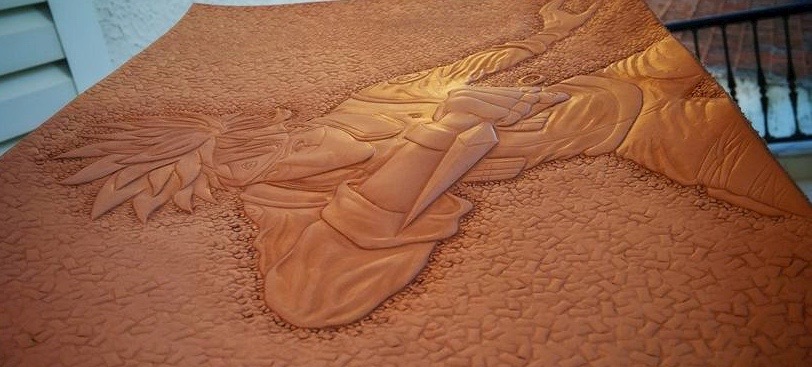-
Posts
2,372 -
Joined
-
Last visited
Content Type
Profiles
Forums
Events
Blogs
Gallery
Everything posted by immiketoo
-
Ian Atkinson has a ton of good content. He is Leodis Leather on youtube. My site also has a lot of good stuff, www.learnleather.com.
-

3D printed mold guns
immiketoo replied to Madmax500000's topic in Gun Holsters, Rifle Slings and Knife Sheathes
Aside from the aforementioned cost issues, the real problem is finding someone who can print the file properly AND making certain the file is correct. Someone did a 3D gun for me and when I got it, the barrel was oval indicating the cloud file had been stretched on one axis. Without the gun or a proper mold, there is NO way to ensure that your 3D prop is correct. I'd hate to make a holster only to find out the gun didn't fit because of an altered file. -

Serge Volken's Two Tool Basketweave-O-Rama
immiketoo replied to immiketoo's topic in How Do I Do That?
I agree. He is one of the coolest people I know. Well worth the time to watch. Serge is about as creative as they come. He puts an amazing amount of thought into his classes. -
Thanks man, Serge is a master of unconventional thinking. Plus he's jut a cool dude to hang out with. This class is also about minimalism and making awesome things with limited tools.
-
It takes four times the planning and execution of normal BW, but its awesome looking and you can fit it anywhere.
-
Thats the only way. The reason most people use a camo tool at the edge of basketweave is to hide that faded from angling the tool. The only other way to get it to the edge is to hand carve your basketweave. Its a different look but its cool.
-
May sound silly but what about corn meal and super glue? Or something similar?
- 48 replies
-
Hmmm...I never use edge paint as a single application, so I don't know. Maybe leather dust and glue? What are you making? And, I hate to ask, but are you hammering your seams? You are pretty accomplished, so I assume you are, but trying to help find a solution...
- 48 replies
-
Pics would help diagnose what you're trying to achieve, but generally I try to avoid all gaps in edges that are glued before I start my edge finishing process. If there is a gap, edge paint generally covers what I need it to with a little work. If I really needed to, I may make a custom plug out of veg tan and fill the gap that way but that is fixing a problem that shouldn't exist.
- 48 replies
-

Edge paint VS Burnished edges showdown!!!
immiketoo replied to immiketoo's topic in How Do I Do That?
Point is that I doubt other edge processes would hold up any better on soaked leather. Not buying a liter of anything you don't have a use for or a solid process in place with is good advice though! -

Edge paint VS Burnished edges showdown!!!
immiketoo replied to immiketoo's topic in How Do I Do That?
I don't think that his tests invalidates the use of this product. I don't know ANY leather gear designed to stand up to what he did to it. I use the exact same process when I apply it, and it has stood up to all kinds of bending, folding and deliberate scratching. It doesn't come off. All I do for a finish is use RTC over the entire product, although its not necessary. Any leather product would fare poorly under the conditions you put it through. As a foot note, I don't use the top coat. Only the edge paint. -
If you're using edge paint, I wouldn't use gum trag with it as theres nothing for the paint to stick to. In fact, I wouldn't use gum trag at all. Ever. So many better ways to get a good edge with leather. If you're using dye to color your edges, you can do it without trag. Apply dye, slick, wax, sand, repeat until smooth.
-

Serge Volken's Two Tool Basketweave-O-Rama
immiketoo replied to immiketoo's topic in How Do I Do That?
YEssir, its online as are all of my classes. Serge is going to make this one a lot of fun! -
Floral tooling is the most tedious aside from perhaps celtic work. Don't stop now!
-
I have the big red, and its pretty nice and you can find it here or by contacting them. https://chuck-smith-leather-tools.myshopify.com Also, maybe check out the new sharpener by Gordon Andrus. Its fantastic. you can find it here: http://sagecreeksaddles.com/red-ox-brand-tools/ Alternatively, I made myself a wedge out of leather at the angle I want and just use high grit sand papers to sharpen, using the wedge to help me keep the angle. After a while, I don't need the wedge anymore and can do it by hand. Its a lot cheaper and works if you put the time in.
- 5 replies
-
- swivel knife
- barry king
-
(and 2 more)
Tagged with:
-
When it comes to tools, there as many variables as there are leather workers. Usually, saddle makers have the largest sized stamping tools available in the range of tools due simply to the size of saddles. This is not always the case, and seems to be less so today than say, 50 years ago. This is likely because back then, Craftool were the main supplier of tools and custom makers were not as prevalent. The Craftool camouflage 455 is more than an inch wide, so its HUGE compared to most of the other camo tools made even by Tandy back then. Now days, I don't know anyone who makes a camo that big, but old craftool had an entire range of larger sized tools which are still available on eBay or from private sellers. They are also great value for money as the most expensive of them is 15 bucks, whereas pro tools usually start around 30 dollars and go up. Now, guys like Barry King and Wayne Jueschke make several sizes of all their tools in order to meet the demands of modern leatherworkers while Craftool is lagging behind a little bit. Earlier, I mentioned pro tools. I consider makers like Bob Beard, Barry King, Clay Miller and Wayne (And others) pro tool makers. They are far superior to modern Tandy offerings (Not so much with the old craftool as they are quite good) in terms of materials, crispness of impression and variety of designs, ESPECIALLY in the geometric tools area. Tool purchasing can be a HUGE investment if you're not careful, and I speak from experience. I like quality tools, and the results I get from them, however I have 10 or 20 times the tools I need. I bought a lot in the beginning because I didn't know what kind of tooling I'd prefer and I dabbled in everything. So I have a full Sheridan set from Barry King, a reasonably full set of figure carving tools from Bob Beard and a few tools from Wayne because they're amazing. All of that being said, if I knew then what I knew now, I'd have quite a few more old pre-letter craftool tools and a lot less of the others. Not because they're no good, but because my style of carving has developed to the point where I can manipulate fewer tools in a wider variety of ways to achieve the same effects as a lot of the tools in my racks that now go unused for the most part. Now, more to the point. If you know what you want to do and you've identified a need for larger tools, and you've looked at the makers I've listed and can't find what you need, then it might be time for some full on custom tools. Backgrounders are tricky though because the larger the tool face, the more difficult it becomes to strike the tool and get a good impression. So then you need a heavier maul or you need to really watch the heck out of it with your smaller one. My guess is that you'll find what you need already in existence if you look at only those makers listed above. Good luck!
-
Stohlman Award winner, Serge Volken has teamed up with learn leather.com to teach his basketweave class! Check out this teaser video for the upcoming class! If you'd like to join Serge for this awesome class, you can register here: https://attendee.gototraining.com/r/34199600688760578
-
Sometimes, its the stamp itself. Especially if you rotate it without noticing. They are not all equal. Mark one side of the tool so you always use the same face.
-
These? https://www.sailrite.com/Snap-Fastener-Cloth-to-Surface-Silver-Button-3-8-Screw-Stud
-

The Outlaw has finally Struck....
immiketoo replied to bikermutt07's topic in Leather Sewing Machines
I have noticed this as well. Things I wouldn't think twice about lifting, now require help or disassembly. I call it wisdom, though Daaaaaannng.- 28 replies
-
- cowboy outlaw
- cowboy outlaw sewing machine
- (and 3 more)
-
Lol...I came from Chicago where in winter 5% was considered high! Poor cat couldn’t walk without static discharges. I swear she would glow at night! Now, as mentioned above, it can be 100% and not rain here with the salt air and the basin I live in. Sometimes there are droplets if water hanging from the ceiling! I went from one extreme to the other. On the plus side, my wood handles and guitars are much happier. Down side is mold. Lots and lots of mold.
- 55 replies
-

Edge paint VS Burnished edges showdown!!!
immiketoo replied to immiketoo's topic in How Do I Do That?
I’m using barge or the equivalent. The cobblers hammer sets the glue and fibers tightly together and makes edging easier. I agree about the time outlay on edge coat. As this was really my first time, the time expenditure is much higher than my traditional edge which took less than a minute or two total. Where I disagree is about the durability of the Italian edge paints. If applied properly, they are more durable in the field and will stand up to years if not decades of use. High end Italian bag makers have been using similar products for decades with great success. Perhaps you are referring to edge-kote? That stuff is truly horrendous, which is why I was a staunch traditional edge guy like you until recently. However, the real benefit is when using dissimilar leathers, say veg tan outer and chrome tan liner. Then you can have a nice finished edge where traditional methods wouldn’t work. Then again, I doubt I’ve made 40 of anything other than holsters, so there’s a decided gap in output between us. -
We fight high humidity all year round on the island, but its way worse in the winter. We run a dehumidifier constantly from October to May. Probably pull 5 gallons a day.
- 55 replies
-
Thats actually a good idea about the hair dryer. Might have to give that a try sometime.
- 55 replies


